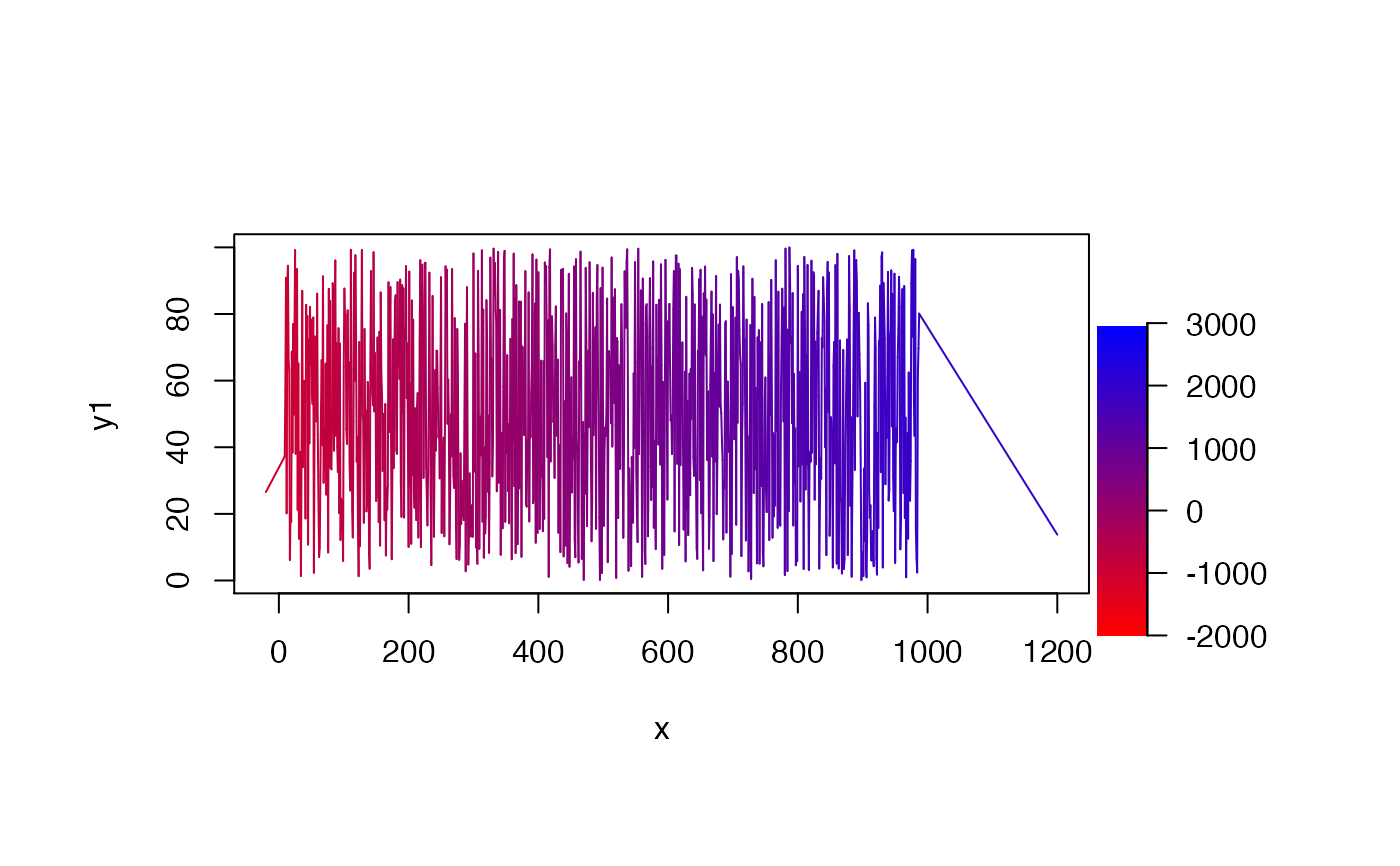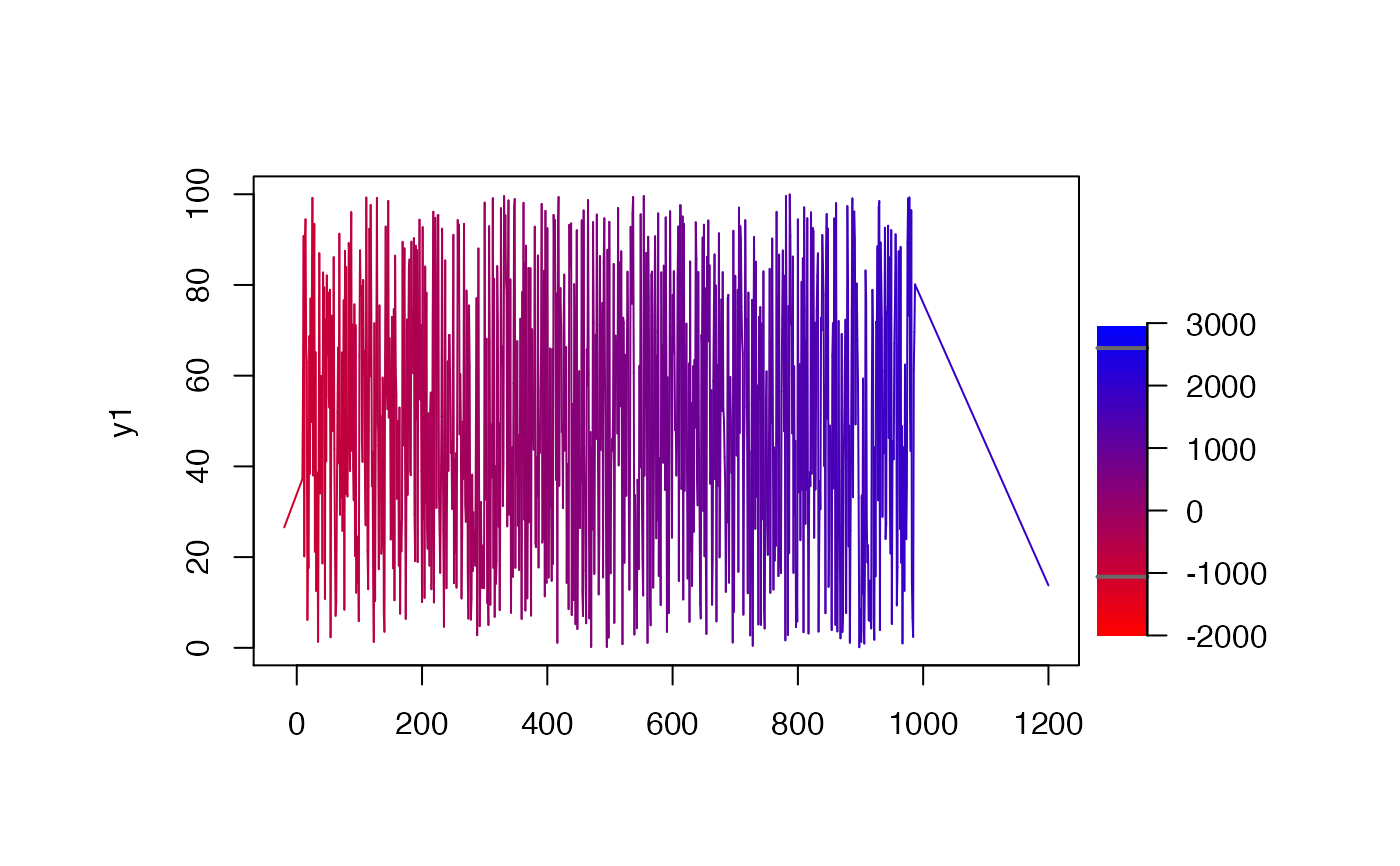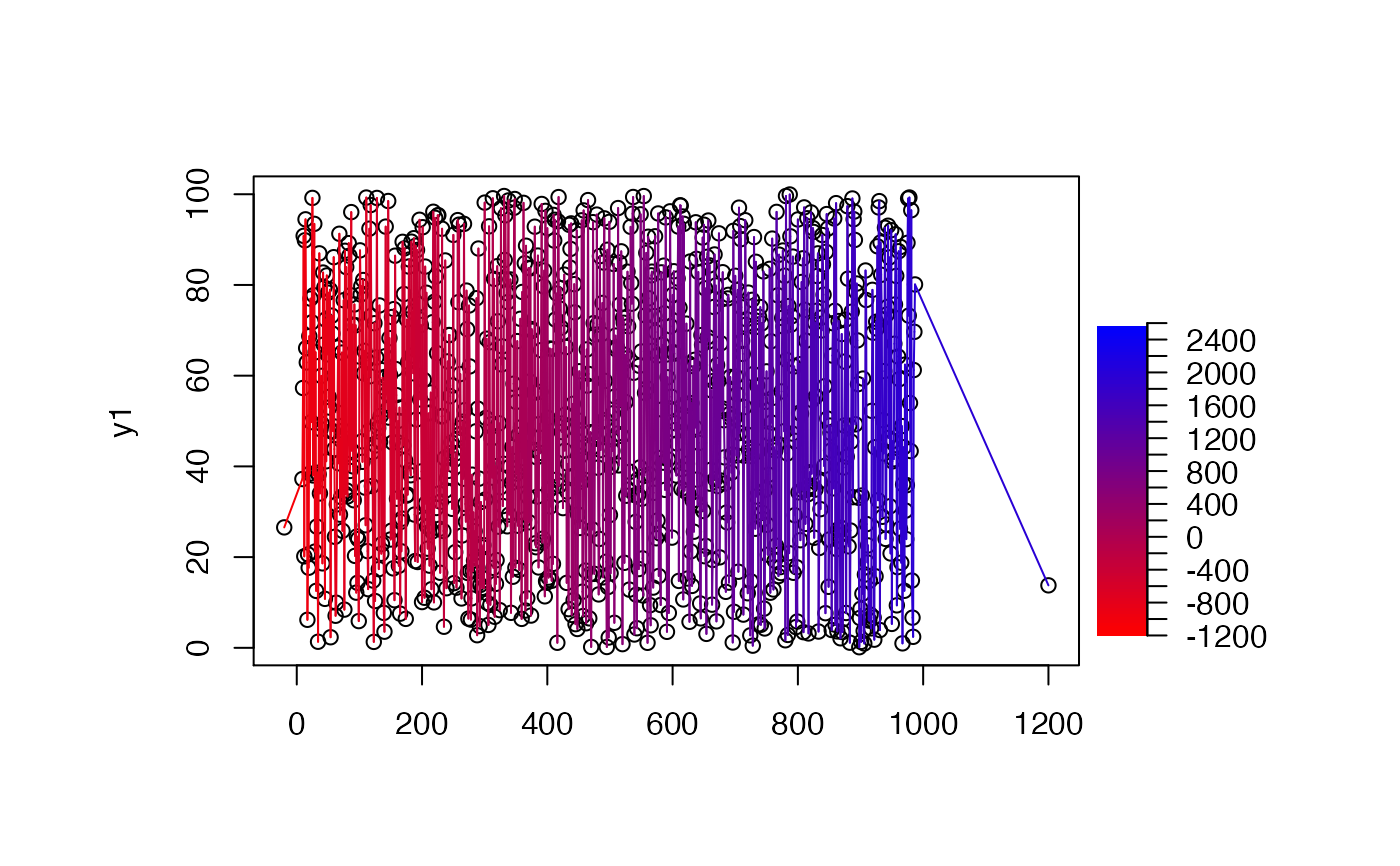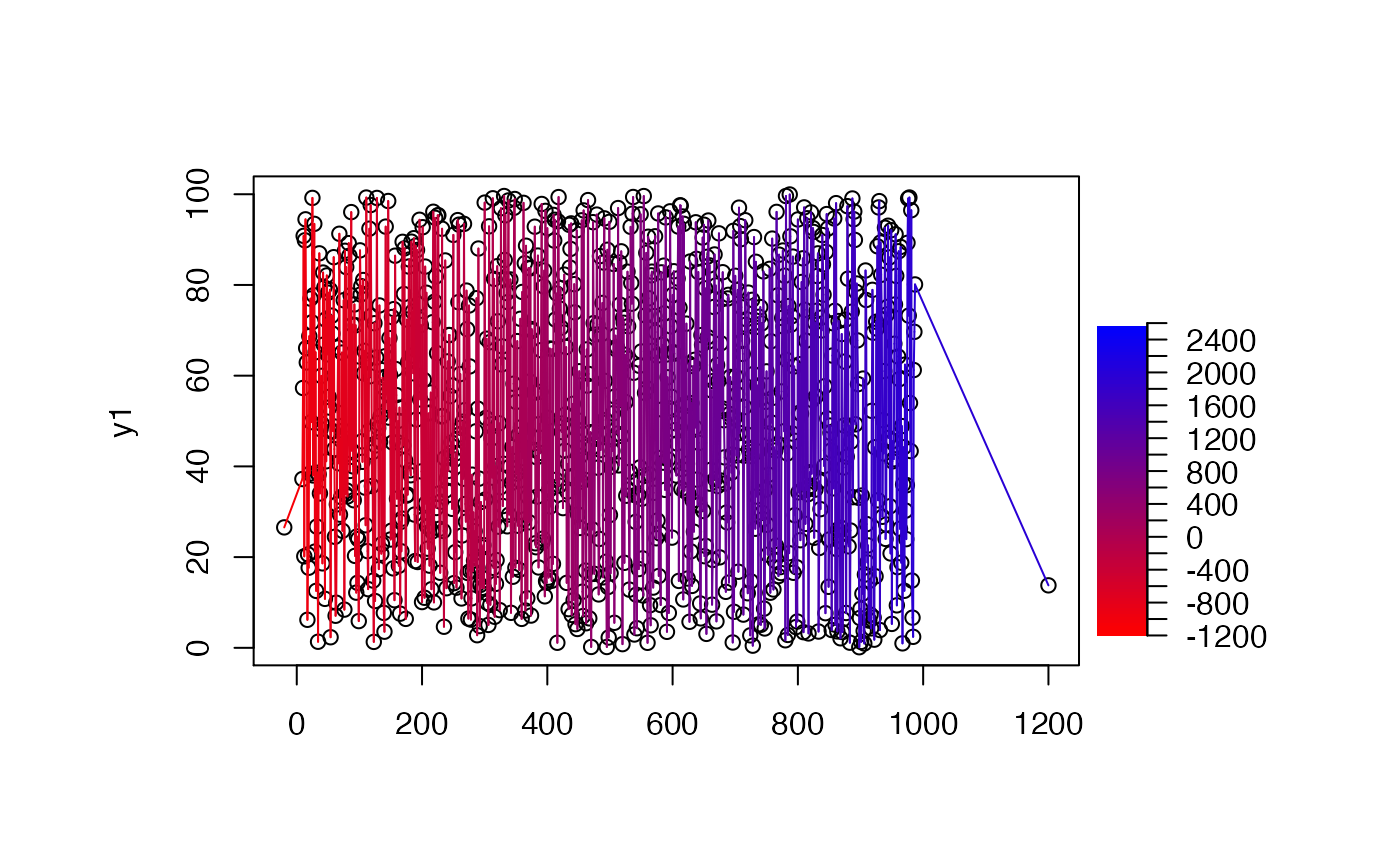This function adds a colour bar legend to a plot. The function accompanies add_lines and can be used to add a legend which corresponds to the lines drawn. This can be added to an existing plot using subplot.
add_colour_bar( data_legend, pretty_axis_args = list(), mtext_args = list(), data_raw = NULL, mark_args = list() )
Arguments
| data_legend | A dataframe with two columns named 'x' and 'col'. 'x' is a regular sequence of values. 'col' is the colour of each value. This is used to define the colour bar. |
|---|---|
| pretty_axis_args | A list of arguments passed to |
| mtext_args | A list of arguments passed to |
| data_raw | (optional) A numeric vector that contains the raw data to which the the colour bar refers. If provided, |
| mark_args | (optional) A list of arguments passed to |
Value
The function return a plot of the colour bar. This can be added to an existing plot with subplot.
Author
Edward Lavender
Examples
#### Define some data set.seed(1) x <- c(-20, 9, 10:987, 1200) y1 <- runif(length(x), 0, 100) y2 <- x*3-1000 #### Plot graph and add colour line, saving output of add_lines to a list: plot(x, y1)#### Example (1): add_colour_bar uses outputs of add_lines and returns a plot add_colour_bar(data_legend = colour_line_ls$data_legend, pretty_axis_args = colour_line_ls$axis_legend )#### Example (2): add_colour_bar can be used in combination with TeachingDemos::subplot() pp <- par(oma = c(2, 2, 2, 6)) plot(x, y1, type = "n"); add_lines(x, y1, y2)TeachingDemos::subplot(add_colour_bar(data_legend = colour_line_ls$data_legend, pretty_axis_args = colour_line_ls$axis_legend ), x = 1275, y = 0, size = c(0.25, 2.75), vadj = 0, hadj = 0 )par(pp) #### Example (3): the mtext_args argument can be used to add a label pp <- par(oma = c(2, 2, 2, 6)) plot(x, y1, type = "n"); add_lines(x, y1, y2)TeachingDemos::subplot(add_colour_bar(data_legend = colour_line_ls$data_legend, pretty_axis_args = colour_line_ls$axis_legend, mtext_args = list(side = 4, text = "Legend", cex = 1.5, font = 2, line = 3), ), x = 1275, y = 0, size = c(0.25, 2.75), vadj = 0, hadj = 0 )par(pp) #### Example (4): data_raw and mark_args can be used to delineate the range of data pp <- par(oma = c(2, 2, 2, 6)) plot(x, y1, type = "n"); add_lines(x, y1, y2)TeachingDemos::subplot(add_colour_bar(data_legend = colour_line_ls$data_legend, pretty_axis_args = colour_line_ls$axis_legend, data_raw = y2, mark_args = list(col = "dimgrey", lwd = 2) ), x = 1275, y = 0, size = c(0.25, 2.75), vadj = 0, hadj = 0 )par(pp) #### Example (5): the lower and upper data delimiters can be controlled independently # ... using a nested list: pp <- par(oma = c(2, 2, 2, 6)) plot(x, y1, type = "n"); add_lines(x, y1, y2)TeachingDemos::subplot(add_colour_bar(data_legend = colour_line_ls$data_legend, pretty_axis_args = colour_line_ls$axis_legend, data_raw = y2, mark_args = list(list(col = "dimgrey"), list(col = "green")) ), x = 1275, y = 0, size = c(0.25, 2.75), vadj = 0, hadj = 0 )par(pp) #### Example (6): the axis harnesses the power of pretty_axis() and can be adjusted # For example, in Example 5, it is clear that the colour bar extends # ... beyond the range of the data. This is the default behaviour for pretty_axis() # .... but we can force pretty labels to lie within the range of the data by adjusting # ... the initial call to add_lines() to incorporate fixed limits # ... in the pretty_axis_args argument: par(oma = c(2, 2, 2, 6)) plot(x, y1)colour_line_ls <- add_lines(x, y1, y2, pretty_axis_args = list(lim = list(range(y2)), pretty = list(n = 5)) )TeachingDemos::subplot(add_colour_bar(data_legend = colour_line_ls$data_legend, pretty_axis_args = colour_line_ls$axis_legend ), x = 1275, y = 0, size = c(0.25, 2.75), vadj = 0, hadj = 0 )par(pp) #### Example (7): another option is to increase the number of pretty breaks # ... so the pretty axis and limits of the data line up well: par(oma = c(2, 2, 2, 6)) plot(x, y1)TeachingDemos::subplot(add_colour_bar(data_legend = colour_line_ls$data_legend, pretty_axis_args = colour_line_ls$axis_legend ), x = 1275, y = 0, size = c(0.25, 2.75), vadj = 0, hadj = 0 )par(pp) #### Example (8): other axis customisation options are best handled via pretty_axis_args, e.g.: par(oma = c(2, 2, 2, 6)) plot(x, y1)colour_line_ls <- add_lines(x, y1, y2, pretty_axis_args = list(pretty = list(n = 20), axis = list(las = 2)))TeachingDemos::subplot(add_colour_bar(data_legend = colour_line_ls$data_legend, pretty_axis_args = colour_line_ls$axis_legend ), x = 1275, y = 0, size = c(0.25, 2.75), vadj = 0, hadj = 0 )








